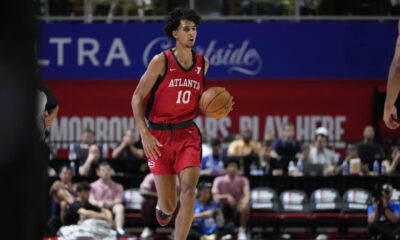
NFL running backs have grown increasingly displeased with the current state of their position, as long-term extensions are rarer than ever.
The story of the NFL summer has been a sad one for those who carry the rock in today’s league. Although the issue has been intensifying for years, the situation came to a head this offseason as nearly every big name in the running game spoke out about their contract struggles. NFL running backs have shorter perceived primes than ever before, and they aren’t paid according to their value during those potentially lucrative years.
The Running Backs
While Le’Veon Bell, Melvin Gordon III, Todd Gurley II, and others have faced comparable situations in seasons past, the conundrum was significantly more widespread this time around. Let’s take a look at the offseasons of Austin Ekeler, Ezekiel Elliott, Tony Pollard, Saquon Barkley, Josh Jacobs, and Jonathan Taylor.
Austin Ekeler has been the most vocal of the ballcarriers about the issue ever since his extension negotiation with the Los Angeles Chargers broke down in March. Tom Telesco and Co. in the front office granted Ekeler permission to seek a trade, but he found no buyers. Ekeler expressed his frustration with his underpaid role, later hosting a Zoom with other premier running backs hoping to find a solution. Ekeler will enter free agency after his 2023 campaign, finishing a contract with an AAV (average annual value) of just over $6 million. That relatively paltry number doesn’t even begin to describe Ekeler’s value to the Bolts. His 2022 campaign consisted of 915 rushing yards on 4.5 Y/A (yards per attempt) along with 107 receptions (beating out the rest of the receiving core on the team and second-most all-time for an RB) and 722 receiving yards. The dual-threat back seemed particularly suitable for the pass-heavy offenses of today’s NFL, especially at 28 years old, but no club seemed to believe he was worth the risk.
Ezekiel Elliott represents the aforementioned “risk”. He was cut by the Dallas Cowboys in May, ending a seven-year tenure. Elliott burst onto the scene as a rookie in 2016, finishing third in MVP voting as a 1st-team All-Pro. In the six seasons since, Dallas faithful have seen his attempts per season, yards per season, yards per attempt, and yards per game steadily decline from his 2016 mark of 1,631 rushing yards on 5.1 Y/A to a Cowboys tenure-ending mark of 876 yards on 3.8 Y/A. He, like Ekeler, is 28. He’ll be paid around $3 million next season by the Patriots and thrown into free agency after that, just like Ekeler.
Tony Pollard, two years Elliott’s junior, hastened Zeke’s departure from Dallas by putting up Pro Bowl numbers on the ground for the Cowboys in 2022. Pollard is not without his own contract struggles, though. He’ll play this upcoming year on a $10 million franchise tag that expires after the season. The franchise tag allows a team to keep a player entering unrestricted free agency on the club for an additional season (teams get only one of these to use every year). First implemented in 1993, the tag has now become the bane of many running backs’ existence.
Saquon Barkley won’t have to play on the franchise tag in 2023. But his alternative, a one-year, $11 million deal, is hardly much better. Barkley has a strong case as the league’s most valuable back, powering the long-suffering New York Giants to a playoff berth and subsequent win in the 2022 season, but it was his middle-of-the-pack signal caller Daniel Jones who struck it rich this offseason with a mammoth 4-year, $160 million deal demonstrating just how expensive quarterbacks have become.
Josh Jacobs was franchise-tagged as well, but the 2022 rushing champion refused to sign it. He began a holdout where he refused to attend mandatory training camps and preseason games until he was offered a better (perhaps longer) contract. Jacobs eventually settled for a slight upgrade, perhaps fearing a repeat of Le’Veon Bell’s mistake. He’ll play on a one-year deal worth up to $12 million, not much more than a franchise tag.
The most recent (and perhaps biggest) development in this saga is Jonathan Taylor failing to find an adequate trade offer after being granted permission by the Colts to seek one. With trade talk off the table, his extended holdout now forces him to miss at least the first four games of the season (fellow BSP writer Jacob Oskorus presciently predicted this when Taylor first requested a trade). Taylor is just 24 years old, but the structure of his rookie contract makes it difficult for him to be paid according to his worth.
The Problem
As put rather dishearteningly by Matt Miller, there are five cheap years for a running back to contribute before he is seen as expendable.
Been saying it for years:
1. Draft a RB
2. Play the RB…if he’s good…
3. Franchise tag the RB ONE TIME
…and then…
1. Draft a RB…
— Matt Miller (@nfldraftscout) July 17, 2023
https://platform.twitter.com/widgets.js
This is, by most metrics, unfair. But unfairness doesn’t necessarily prompt change. What may encourage the NFL to change is the evaporation of running back prospects. This saga has been widely publicized, making headlines in the sports world multiple times throughout the spring and summer. High schoolers and college backs, still early in their development, might notice the significantly less lucrative nature of the position and consider a switch to wide receiver or tight end, positions with longer primes and larger paydays. While this process would take years to become evident, its fallout could seriously damage the game.
If a short career is a fact of life for running backs, the rookie contract denies them the ability to be compensated for their full value during their prime. The structure of a rookie contract is similar to that of quarterbacks: four years followed by a fifth-year option (for first-round picks) with potential subsequent franchise tags (for everyone). For quarterbacks whose careers can last up to 20 years, it’s a good deal. For running backs whose primes last around five years, it’s subpar.
The Solution
The NFL needs to rethink the structure of rookie contracts for running backs. The new structure should preserve the four-year guarantee allowing running backs to develop at their own pace, but there should be an early out so that those who demonstrate their value have the opportunity to be compensated for it before they are seen as past their prime. The rookie deal should include a player opt-out after the second and following seasons. Elite young rushers like Jonathan Taylor would be able to enter free agency at the height of their value, while guys still figuring things out like, say, Cam Akers, wouldn’t see their careers tanked by injury or limited playing time early on (which would be the case if rookie contracts lasted just two years total).
One could argue this is contrary to the purpose of the draft in the cases of elite prospects. The draft is structured so that the teams struggling the most get the best picks and have time to develop them as they rebuild. If running backs could choose to leave their teams in pursuit of more consistent squads after just two seasons, it could make rebuild attempts languish. This may be the case for quarterbacks, very often drafted high, but running backs rarely go on the first day of draft night anyway. The last three drafts have seen only three running backs drafted across the first two rounds in each one. In 2023, two of those three backs that were drafted went to winning teams. Drafting a running back early does not connote a rebuild like picking a quarterback does. The first three quarterbacks taken in 2023 went to teams with a combined record of 14-35-2.
If running back picks might only last two years, their value in the draft might plummet much further than it already has. As predominantly Day 3 picks, their initial contracts would be cheaper, but that doesn’t affect their performance. Jonathan Taylor would probably have accepted lower pay on his rookie contract if it meant he could become a free agent after 2021 when he was the rushing champion.
This adjustment would significantly aid running backs in their quest for pay proportional to their value, but only if they’re drafted. Whither the undrafted? To protect those that beat the odds like Austin Ekeler (especially when star UDFA RBs would become more common with only a few RBs drafted), the opt-out after the second and subsequent years could apply to all running back contracts as long as they reach a certain threshold of percentage of snaps at the position.
But this sweeping change in running back contract structure can’t be implemented until at least 2030 after the new CBA between the owners and the NFLPA is implemented. And as its full name implies, the CBA (collective bargaining agreement) would require broad-based support from all position groups when negotiating with the owners. What’s in it for non-running backs? Therein lies the rub.
If the running back-specific concession was met with scoffs by the rest of the position groups, Andrew Brandt proposed an alternate solution that applies to everyone. The host of the DraftKings Network podcast “The Business of Sports” suggested that the draft eligibility rules be modified so that players could declare for the draft just one year removed from high school, instead of the current requirement of three years. Running backs could specifically take advantage of this by reaching free agency in their early 20s with enough prime years remaining to earn a value-equivalent, multi-year contract. Of course, college football experience is still seen as a valuable stepping stone toward the NFL, and limited playing time at that level is often a valid knock on a prospect (see: Trey Lance).
As for this coming generation of running backs, highlighted by Bijan Robinson and Jahmyr Gibbs, the change has to come on the field. Maybe those who factor heavily in the passing game like Austin Ekeler and Christian McCaffrey (28 and 27, respectively, near the end of the perceived RB prime) can demonstrate how running backs can increase their longevity.
In a pass-dominated league, choosing the ground attack can seem unexciting to some. But rushing prowess can make some of the most exciting moments in football. Take Travis Etienne Jr.’s game-clinching 4th-and-1 run during the Jaguars’ 31-30 comeback against the Chargers in the Wild Card Round, arguably the most exciting game of that postseason (Etienne had 121 total yards that day). Or Josh Jacobs’ ridiculous 86-yard sprint to beat the Seahawks in overtime (How about 303 scrimmage yards that day?!) Football needs the running back, and running backs need, well, money.












